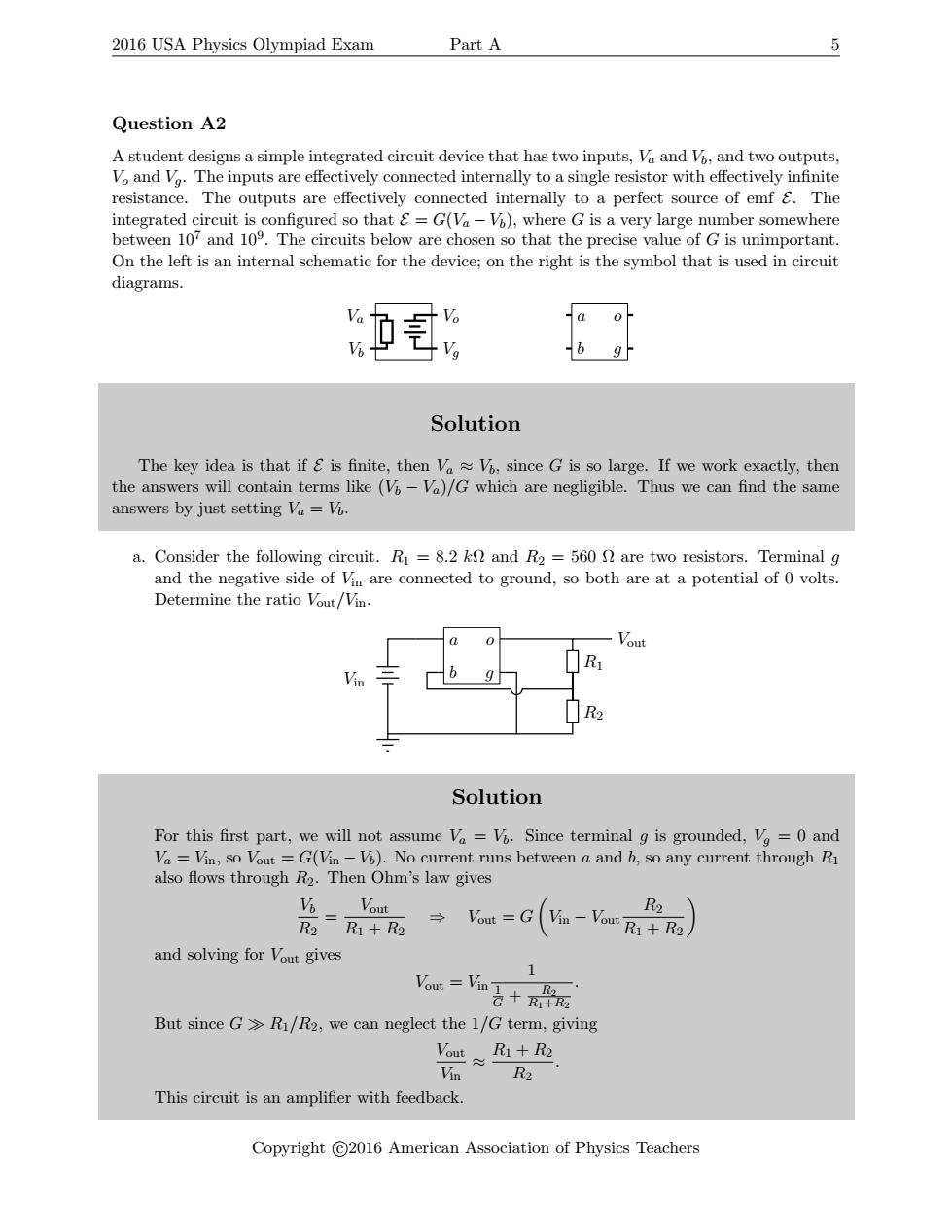正在加载图片...

2016 USA Physics Olympiad Exam Part A 5 Question A2 A student designs a simple integrated circuit device that has two inputs,Va and V,and two outputs, Vo and V.The inputs are effectively connected internally to a single resistor with effectively infinite resistance.The outputs are effectively connected internally to a perfect source of emf &The integrated circuit is configured so that &=G(Va-V),where G is a very large number somewhere between 107 and 109.The circuits below are chosen so that the precise value of G is unimportant. On the left is an internal schematic for the device;on the right is the symbol that is used in circuit diagrams. 0 Solution The key idea is that if is finite,then VaVo,since G is so large.If we work exactly,then the answers will contain terms like (V-Va)/G which are negligible.Thus we can find the same answers by just setting Va =Vo. a.Consider the following circuit.R1 =8.2 kn and R2 =560 are two resistors.Terminal g and the negative side of Vin are connected to ground,so both are at a potential of 0 volts. Determine the ratio Vout/Vin Vout Solution For this first part,we will not assume Va =V.Since terminal g is grounded,V=0 and Va =Vin,so Vout =G(Vin-V).No current runs between a and b,so any current through Ri also flows through R2.Then Ohm's law gives Vout Vout=G1 R2 → -Vout R1+R2 and solving for Vout gives Vou V But since G>RI/R2,we can neglect the 1/G term,giving Vout≈ 1+B2 a R2 This circuit is an amplifier with feedback. Copyright C2016 American Association of Physics Teachers2016 USA Physics Olympiad Exam Part A 5 Question A2 A student designs a simple integrated circuit device that has two inputs, Va and Vb, and two outputs, Vo and Vg. The inputs are effectively connected internally to a single resistor with effectively infinite resistance. The outputs are effectively connected internally to a perfect source of emf E. The integrated circuit is configured so that E = G(Va − Vb), where G is a very large number somewhere between 107 and 109 . The circuits below are chosen so that the precise value of G is unimportant. On the left is an internal schematic for the device; on the right is the symbol that is used in circuit diagrams. Va Vb Vo Vg a b o g Solution The key idea is that if E is finite, then Va ≈ Vb, since G is so large. If we work exactly, then the answers will contain terms like (Vb − Va)/G which are negligible. Thus we can find the same answers by just setting Va = Vb. a. Consider the following circuit. R1 = 8.2 kΩ and R2 = 560 Ω are two resistors. Terminal g and the negative side of Vin are connected to ground, so both are at a potential of 0 volts. Determine the ratio Vout/Vin. a b o g R1 R2 Vout Vin Solution For this first part, we will not assume Va = Vb. Since terminal g is grounded, Vg = 0 and Va = Vin, so Vout = G(Vin − Vb). No current runs between a and b, so any current through R1 also flows through R2. Then Ohm’s law gives Vb R2 = Vout R1 + R2 ⇒ Vout = G Vin − Vout R2 R1 + R2 and solving for Vout gives Vout = Vin 1 1 G + R2 R1+R2 . But since G
R1/R2, we can neglect the 1/G term, giving Vout Vin ≈ R1 + R2 R2 . This circuit is an amplifier with feedback. Copyright c 2016 American Association of Physics Teachers